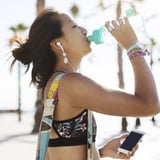dimanche 2 août 2020
Tips For Staying Healthy and Headache-Free When the Heat Index Won't Quit

I'm so much better about sun safety than I used to be (no more marathon beach days; SPF is now my favorite summer accessory), but I'd be lying if I said I was fluent in all the rules of staying healthy when the heat index hits 100.
Preventing sunburn is just one small part - prolonged exposure to heat can bring on pounding dehydration headaches (been there, and they're awful) and other serious and potentially dangerous heat illnesses.
Before heading out for your social-distance park hangout, be sure to read up on these safety tips from Dr. Lilli Link, MD, a board-certified internist and functional medicine practitioner at Parsley Health.
First, let's tackle heat headaches and one of its major causes: dehydration.
"Assuming you are heading out into a hot summer sun and will be out for a while, you want to start by being adequately hydrated. That doesn't mean that you need to drink extra water before you head out, because you don't become dehydrated in the first minute you are outside. But do bring water with you and start drinking it early on and throughout the time you are outside." Dr. Link says. Conscientiously sipping on a chilled canteen isn't the only way to stay properly hydrated - your diet can also play a part here. "For example, a cucumber or watermelon is mostly liquid, so those would be hydrating foods, whereas a high protein diet is dehydrating," Dr. Link says.
Keep in mind - your urine output and the color of your urine can signal dehydration: "if you are not urinating or your urine is turning yellow, you are getting dehydrated," Dr. Link explains.
Avoiding alcohol (it's dehydrating!), wearing a hat or staying under an umbrella, wearing polarized sunglasses that cut the glare of the sun, avoiding excessive exercising, and cooling off periodically with a dip on the pool or nearby water feature, and placing a cold, wet cloth on your head are all ways you can help prevent heat headaches, Dr. Link explains.
Following sun safety best practices can also help decrease your risk of developing a "heat -related illness" - which includes heat stroke, heat exhaustion, heat cramps, heat rash, and sunburn," according to the CDC. It's important to note that not all of these conditions are treated the same and drastically range in severity. According to Dr. Link, "heat illness can be deadly or cause serious harm."
For example, Dr. Link says that heat stroke is a medical emergency, and those who are showing signs of heat stroke should seek medical attention immediately. Heat exhaustion can also be an emergency condition, "if you are throwing up and can't keep fluids down."
Given the potential severity of heat illness, it's key to follow preventive tips - and there are many! Start by wearing a hat, wearing polarized sunglasses, staying under an umbrella, and wearing light, loose clothing in the heat. As mentioned above, you'll also want to avoid alcohol, which can dehydrate you, and avoid excessive exercise.
Other than drinking water to stay hydrated, Dr. Link suggests drinking slushy/crushed ice drinks. "They help cool your core temperature better than just cold drinks - but try to stay away from sugary drinks as those will be bad for your health in other ways."
Again, considering cooling off periodically or placing a cold, wet cloth on your head, and if you're feeling very hot, Dr. Link says you can "immerse your hands or forearms in cold water for 20 minutes - this helps lower your core temperature." Dr. Link also notes avoiding sunburn and going out in the heat of the day - which is between 10 a.m. and 4 p.m.
Click here for more health and wellness stories, tips, and news.










0 comments:
Enregistrer un commentaire